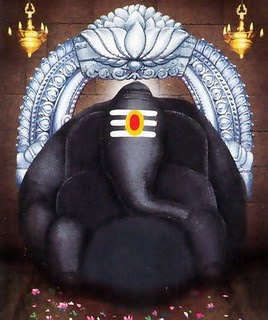Exploring the Legend of Kanipakam: Unraveling the Name and Origin:
Kanipakam, a name composed of "KANI," symbolizing an expanse of one and a
quarter acres, and "PAKAM," denoting the flow of water for irrigation,
encapsulates a captivating tale entrenched in ancient lore.
Centuries
ago, within the serene landscape, three brothers, each afflicted with
physical impairments—deafness, muteness, and blindness—resided. Their
livelihood relied on the cultivation of a modest plot of land. During
their routine efforts to fetch water for their fields, an unforeseen
crisis arose—their well had run bone dry. Faced with this dire
situation, one of the brothers, in an attempt to restore the well's
water levels, struck a rock within its depths. To their astonishment,
this act triggered a sudden release of blood, transforming the tranquil
waters into a crimson hue.
Amidst this surreal spectacle, their
persistent endeavors yielded an extraordinary revelation—a Swayambhu
idol of Swamy Vinayaka emerged. Overwhelmed with profound joy and
reverence, the brothers, in humble devotion, offered fervent prayers, a
profusion of coconuts, and performed Mangalahaarathi rituals to venerate
the divine idol. This auspicious event marked the sacred declaration of
the idol as Swayambhu—an entity self-manifested.
The divine
blessings bestowed upon them echoed through the ceremonial offering of
coconut water. These offerings cascaded through ingenious channels,
traversing an area extending over one and a quarter acres—an event that
etched the very essence of "KANIPAKAM" into existence.
Despite
the passage of time shrouding the exact genesis of the temple in
mystery, historical narratives speak of its existence dating back a
thousand years. The enduring legacy of Kanipakam remains evident today,
manifested in the perpetual flow of water encompassing the divine
presence of Swamy. This incessant flow, particularly magnified during
the monsoons, serves as an eternal testament to the temple's mythical
origins and divine significance.
The Symbolism and Evolution of Kanipakam
The Swayambhu idol at Kanipakam Temple bears a profound significance encapsulated within its very form. Evident upon the deity is a head wound, a relic from a time when an iron weapon struck it. This distinct mark stands as a testament to the idol's origin and mystique.
An intriguing facet unfolds as the Swayambhu idol exhibits a perpetual growth. Initially, during its discovery, only the head portion of the deity was visible. However, as time passed, the idol's manifestation extended, now revealing itself up to the abdomen—a tangible representation of the deity's continuous expansion.
To epitomize this perpetual growth, a silver "KAVACHAM" generously bestowed by Smt. Lakshmamma, wife of Bezawada Siddaiah from Aragonda's Gollapalli Village in 1947, now portrays an intriguing contrast. Once fitting and adorning the deity, this Kavacham now appears diminutive, no longer suitable to embellish the evolving idol.
Moreover, the water encompassing the deity within the well holds immense sanctity. It is revered as "PAVITHRA THEERTHAM," distributed among devotees—a sacred offering that embodies divine purity and blessings.
The temple's profound symbolism, reflected in the idol's growth and the sacredness of its surroundings, continues to intrigue and enthrall devotees, marking Kanipakam as a place of perpetual spiritual evolution and reverence.
Significance of Bahuda River:
Kanipakam, where Sri Vinayaka Swamy manifested as "Swayambhu," rests
alongside the Bahuda River, steeped in ancient legends. The river earned
its name from an old Puranam associated with its sacred presence.
Following
the self-elevation of Lord Vinayaka Swamy at Kanipakam, two brothers,
Sankudu and Likhithudu, embarked on a pilgrimage to behold the divine
presence of Lord Swayambhu Sri Vinayaka. Their journey was arduous, and
exhaustion plagued Likhitudu, the younger sibling. Hunger drove him to
seek succor from a mango tree, despite warnings from Sankudu, who
cautioned against plucking fruit belonging to the king. Ignoring the
warning due to fatigue and thirst, Likhitudu consumed the forbidden
fruit.
Regrettably, Sankudu reported the incident to the king,
leading to a severe decree: the younger brother's hands were to be
amputated for the theft. Grief-stricken by the consequences, Sankudu
sought solace by immersing both himself and his brother in the river
near the Swayambhu Vinayaka Temple, fervently praying for divine
intervention. Astonishingly, their prayers were answered as Likhitudu's
lost hands miraculously reappeared.
With immense gratitude, the
brothers sought Darshan of Lord Vinayaka Swamy, offering heartfelt vows
for their blessing. Inspired by this divine benevolence, they shared the
tale of Swayambhu Sri Vinayaka's kindness with the neighboring
villagers. Consequently, the river where Lord Vinayaka reinstated
Likhithudu's hands was revered and henceforth named the "Bahuda River."
This incredible event became a testament to the deity's compassion and
the divine grace emanating from Kanipakam.
Kanipakam Temple: The Sanctum of Truth and Divine Justice
Swayambhu Vinayaka Swamy, renowned as the bestower of Health, Wealth, and Success, garnered immense fame for his auspicious blessings, establishing himself as "Varasiddi Vinayaka" at Kanipakam.
Beliefs surrounding the Swayambhu Sri Varasiddi Vinayaka Swamy Alayam, commonly known as the "Sathya Pramanala Nilayam," resonate deeply within the temple's ethos. A distinctive practice prevails at the Kanipakam temple—swearing (Pramanam) before Lord Varasiddi Vinayaka Swamy, situated along the opposite side. Allegations or doubts against others prompt individuals to summon the accused to make a solemn oath before the deity. Drenched in holy water from the Temple Pond, the accused stand before Lord Vinayaka. Guilty parties often evade this oath, fearing the deity's punitive actions within 40 days upon those making false oaths.
Legends abound, recounting instances where those deceiving the deity faced dire consequences, with one such tale narrating the loss of sight by an individual who made a false oath. Remarkably, even during the British era, oaths taken before Kanipakam Vinayaka Swamy held immense weight, and to this day, critical cases are referred for swearing at this temple. Hence, the Swayambhu Sri Varasiddi Vinayaka Swamy Temple in Kanipakam is revered as the "Sathya Pramanala Nilayam," embodying the belief that falsehood cannot endure in the presence of the divine deity.
Resource taken from official website of kanipakam https://srikanipakadevasthanam.org/




